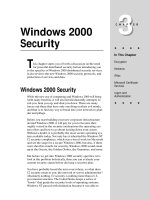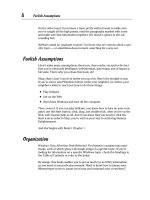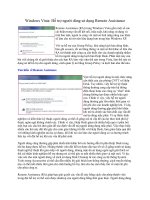Tài liệu Windows Internals covering windows server 2008 and windows vista- P12 doc
Bạn đang xem bản rút gọn của tài liệu. Xem và tải ngay bản đầy đủ của tài liệu tại đây (993.17 KB, 50 trang )
540
You shouldn’t see anything happen, and you should be able to click the Exit button to quit the
application. However, you should still see the Notmyfault process in Task Manager or Process
Explorer. Attempts to terminate the process will fail because Windows will wait forever for the
IRP to complete given that Myfault doesn’t register a cancel routine.
To debug an issue such as this, you can use WinDbg to look at what the thread is currently doing
(or you could use Process Explorer’s Stack view on the Threads tab). Open a local kernel
debugger session, and start by listing the information about the Notmyfault.exe process with
the !process command:
1. lkd> !process 0 7 notmyfault.exe
2. PROCESS 86843ab0 SessionId: 1 Cid: 0594 Peb: 7ffd8000 ParentCid: 05c8
3. DirBase: ce21f380 ObjectTable: 9cfb5070 HandleCount: 33.
4. Image: NotMyfault.exe
5. VadRoot 86658138 Vads 44 Clone 0 Private 210. Modified 5. Locked 0.
6. DeviceMap 987545a8
7. ...
8. THREAD 868139b8 Cid 0594.0230 Teb: 7ffde000 Win32Thread: 00000000 WAIT:
9. (Executive) KernelMode Non-Alertable
10. 86797c64 NotificationEvent
11. IRP List:
12. 86a51228: (0006,0094) Flags: 00060000 Mdl: 00000000
13. ChildEBP RetAddr Args to Child
14. 88ae4b78 81cf23bf 868139b8 86813a40 00000000 nt!KiSwapContext+0x26
15. 88ae4bbc 81c8fcf8 868139b8 86797c08 86797c64 nt!KiSwapThread+0x44f
16. 88ae4c14 81e8a356 86797c64 00000000 00000000 nt!KeWaitForSingleObject+0x492
17. 88ae4c40 81e875a3 86a51228 86797c08 86a51228 nt!IopCancelAlertedRequest+0x6d
18. 88ae4c64 81e87cba 00000103 86797c08 00000000 nt!IopSynchronousServiceTail+0x267
19. 88ae4d00 81e7198e 86727920 86a51228 00000000 nt!IopXxxControlFile+0x6b7
20. 88ae4d34 81c92a7a 0000007c 00000000 00000000 nt!NtDeviceIoControlFile+0x2a
21. 88ae4d34 77139a94 0000007c 00000000 00000000 nt!KiFastCallEntry+0x12a
22. 01d5fecc 00000000 00000000 00000000 00000000 ntdll!KiFastSystemCallRet
23. ...
From the stack trace, you can see that the thread that initiated the I/O realized that the IRP had
been cancelled (IopSynchronousServiceTail called IopCancelAlertedRequest) and is now waiting
for the cancellation or completion. The next step is to use the same debugger extension used in the
previous experiments, !irp, and attempt to analyze the problem. Copy the IRP pointer, and
examine it with the !irp command:
1. lkd> !irp 86a51228
2. Irp is active with 1 stacks 1 is current (= 0x86a51298)
3. No Mdl: No System Buffer: Thread 868139b8: Irp stack trace.
4. cmd flg cl Device File Completion-Context
5. >[ e, 0] 5 0 86727920 86797c08 00000000-00000000
Please purchase PDF Split-Merge on www.verypdf.com to remove this watermark.
541
6. \Driver\MYFAULT
7. Args: 00000000 00000000 83360020 00000000
From this output, it is obvious who the culprit driver is: \Driver\MYFAULT, or Myfault.sys. The
name of the driver emphasizes that the only way this situation can happen is through a driver
problem and not a buggy application. Unfortunately, now that you know which driver caused this
issue, there isn’t much you can do—a system reboot is necessary because Windows can never
safely assume it is okay to ignore the fact that cancellation hasn’t occurred yet. The IRP could
return at any time and cause corruption of system memory. If you encounter this situation in
practice, you should check for a newer version of the driver, which might include a fix for the bug.
7.3.5 I/O Completion Ports
Writing a high-performance server application requires implementing an efficient threading model.
Having either too few or too many server threads to process client requests can lead to
performance problems. For example, if a server creates a single thread to handle all requests,
clients can become starved because the server will be tied up processing one request at a time. A
single thread could simultaneously process multiple requests, switching from one to another as I/O
operations are started, but this architecture introduces significant complexity and can’t take
advantage of multiprocessor systems. At the other extreme, a server could create a big pool of
threads so that virtually every client request is processed by a dedicated thread. This scenario
usually leads to thread-thrashing, in which lots of threads wake up, perform some CPU processing,
block while waiting for I/O, and then, after request processing is completed, block again waiting
for a new request. If nothing else, having too many threads results in excessive context switching,
caused by the scheduler having to divide processor time among multiple active threads.
The goal of a server is to incur as few context switches as possible by having its threads avoid
unnecessary blocking, while at the same time maximizing parallelism by using multiple threads.
The ideal is for there to be a thread actively servicing a client request on every processor and for
those threads not to block when they complete a request if additional
The goal of a server is to incur as few context switches as possible by having its threads avoid
unnecessary blocking, while at the same time maximizing parallelism by using multiple threads.
The ideal is for there to be a thread actively servicing a client request on every processor and for
those threads not to block when they complete a request if additional requests are waiting. For this
optimal process to work correctly, however, the application must have a way to activate another
thread when a thread processing a client request blocks on I/O (such as when it reads from a file as
part of the processing).
The IoCompletion Object
Applications use the IoCompletion executive object, which is exported to Windows as a
completion port, as the focal point for the completion of I/O associated with multiple file handles.
Once a file is associated with a completion port, any asynchronous I/O operations that complete
Please purchase PDF Split-Merge on www.verypdf.com to remove this watermark.
542
on the file result in a completion packet being queued to the completion port. A thread can wait
for any outstanding I/Os to complete on multiple files simply by waiting for a completion packet
to be queued to the completion port. The Windows API provides similar functionality with the
WaitForMultipleObjects API function, but the advantage that completion ports have is that
concurrency, or the number of threads that an application has actively servicing client requests, is
controlled with the aid of the system.
When an application creates a completion port, it specifies a concurrency value. This value
indicates the maximum number of threads associated with the port that should be running at any
given time. As stated earlier, the ideal is to have one thread active at any given time for every
processor in the system. Windows uses the concurrency value associated with a port to control
how many threads an application has active. If the number of active threads associated with a
port equals the concurrency value, a thread that is waiting on the completion port won’t be
allowed to run. Instead, it is expected that one of the active threads will finish processing its
current request and check to see whether another packet is waiting at the port. If one is, the thread
simply grabs the packet and goes off to process it. When this happens, there is no context switch,
and the CPUs are utilized nearly to their full capacity.
Using Completion Ports
Figure 7-23 shows a high-level illustration of completion port operation. A completion port is
created with a call to the Windows API function CreateIoCompletionPort. Threads that block on a
completion port become associated with the port and are awakened in last in, first out (LIFO)
order so that the thread that blocked most recently is the one that is given the next packet. Threads
that block for long periods of time can have their stacks swapped out to disk, so if there are more
threads associated with a port than there is work to process, the in-memory footprints of threads
blocked the longest are minimized.
A server application will usually receive client requests via network endpoints that are represented
as file handles. Examples include Windows Sockets 2 (Winsock2) sockets or named pipes. As the
Please purchase PDF Split-Merge on www.verypdf.com to remove this watermark.
543
server creates its communications endpoints, it associates them with a completion port and its
threads wait for incoming requests by calling GetQueuedCompletionStatus on the port. When a
thread is given a packet from the completion port, it will go off and start processing the request,
becoming an active thread. A thread will block many times during its processing, such as when it
needs to read or write data to a file on disk or when it synchronizes with other threads. Windows
detects this activity and recognizes that the completion port has one less active thread. Therefore,
when a thread becomes inactive because it blocks, a thread waiting on the completion port will be
awakened if there is a packet in the queue.
An important mechanism that affects performance is called lock contention, which is the amount
of time a thread spends waiting for a lock instead of doing real work. One of the most critical
locks in the Windows kernel is the dispatcher lock (see Chapter 5 for more information on the
dispatching mechanisms), and any time thread state is modified, especially in situations related to
waiting and waking, the dispatcher lock is usually acquired, blocking other processors from doing
similar actions.
The I/O completion port mechanism minimizes contention on the dispatcher lock by avoiding its
acquisition when possible. For example, this mechanism does not acquire the lock when a
completion is queued to a port and no threads are waiting on that port, when a thread calls
GetQueuedCompletionStatus and there are items in the queue, or when a thread calls
GetQueuedCompletionStatus with a zero timeout. In all three of these cases, no thread wait or
wake-up is necessary, and hence none acquire the dispatcher lock.
Microsoft’s guidelines are to set the concurrency value roughly equal to the number of processors
in a system. Keep in mind that it’s possible for the number of active threads for a completion port
to exceed the concurrency limit. Consider a case in which the limit is specified as 1. A client
request comes in, and a thread is dispatched to process the request, becoming active. A second
request arrives, but a second thread waiting on the port isn’t allowed to proceed because the
concurrency limit has been reached. Then the first thread blocks waiting for a file I/O, so it
becomes inactive. The second thread is then released, and while it’s still active, the first thread’s
file I/O is completed, making it active again. At that point—and until one of the threads
blocks—the concurrency value is 2, which is higher than the limit of 1. Most of the time, the
active count will remain at or just above the concurrency limit.
The completion port API also makes it possible for a server application to queue privately defined
completion packets to a completion port by using the PostQueuedCompletionStatus function. A
server typically uses this function to inform its threads of external events, such as the need to shut
down gracefully.
Applications can use thread agnostic I/O, described earlier, with I/O completion ports to avoid
associating threads with their own I/Os and associating them with a completion port object instead.
In addition to the other scalability benefits of I/O completion ports, their use can minimize context
switches. Standard I/O completions must be executed by the thread that initiated the I/O, but when
an I/O associated with an I/O completion port completes, the I/O manager uses any waiting thread
to perform the completion operation.
Please purchase PDF Split-Merge on www.verypdf.com to remove this watermark.
544
I/O Completion Port Operation
Windows applications create completion ports by calling the Windows API CreateIo-Completion
Port and specifying a NULL completion port handle. This results in the execution of the
NtCreateIoCompletion system service. The executive’s IoCompletion object is based on the kernel
synchronization object called a queue. Thus, the system service creates a completion port object
and initializes a queue object in the port’s allocated memory. (A pointer
to the port also points to the queue object because the queue is at the start of the port memory.) A
queue object has a concurrency value that is specified when a thread initializes it, and in this case
the value that is used is the one that was passed to CreateIoCompletionPort. KeInitializeQueue is
the function that NtCreateIoCompletion calls to initialize a port’s queue object.
When an application calls CreateIoCompletionPort to associate a file handle with a port, the
NtSetInformationFile system service is executed with the file handle as the primary parameter.
The information class that is set is FileCompletionInformation, and the completion port’s handle
and the CompletionKey parameter from CreateIoCompletionPort are the data values.
NtSetInformationFile dereferences the file handle to obtain the file object and allocates a
completion context data structure. Finally, NtSetInformationFile sets the CompletionContext field
in the file object to point at the context structure. When an asynchronous I/O operation completes
on a file object, the I/O manager checks to see whether the CompletionContext field in the file
object is non-NULL. If it is, the I/O manager allocates a completion packet and queues it to the
completion port by calling KeInsertQueue with the port as the queue on which to insert the packet.
(Remember that the completion port object and queue object have the same address.)
When a server thread invokes GetQueuedCompletionStatus, the system service NtRemoveIo-
Completion is executed. After validating parameters and translating the completion port handle to
a pointer to the port, NtRemoveIoCompletion calls IoRemoveIoCompletion, which eventually
calls KeRemoveQueueEx. For high-performance scenarios, it’s possible that multiple I/Os may
have been completed, and although the thread will not block, it will still call into the kernel each
time to get one item. The GetQueuedCompletionStatus or GetQueuedCompletionStatusEx API
allows applications to retrieve more than one I/O completion status at the same time, reducing the
number of user-to-kernel roundtrips and maintaining peak efficiency. Internally, this is
implemented through the NtRemoveIoCompletionEx function, which calls
IoRemoveIoCompletion with a count of queued items, which is passed on to KeRemoveQueueEx.
As you can see, KeRemoveQueueEx and KeInsertQueue are the engines behind completion ports.
They are the functions that determine whether a thread waiting for an I/O completion packet
should be activated. Internally, a queue object maintains a count of the current number of active
threads and the maximum number of active threads. If the current number equals or exceeds the
maximum when a thread calls KeRemoveQueueEx, the thread will be put (in LIFO order) onto a
list of threads waiting for a turn to process a completion packet. The list of threads hangs off the
queue object. A thread’s control block data structure has a pointer in it that references the queue
object of a queue that it’s associated with; if the pointer is NULL, the thread isn’t associated with
a queue.
Please purchase PDF Split-Merge on www.verypdf.com to remove this watermark.
545
An improvement to the mechanism, which also improves the performance of other internal
mechanisms that use I/O completion ports (such as the worker thread pool mechanism, described
in Chapter 3), is the optimization of the KQUEUE dispatcher object, which we’ve mentioned in
Chapter 3. Although we described how all dispatcher objects rely on the dispatcher lock during
wait and unwait operations (or, in the case of kernel queues, remove and insert operations), the
dispatcher header structure has a Lock member that can be used for an object-specific lock.
The KQUEUE implementation makes use of this member and implements a local, per-object
spinlock instead of using the global dispatcher lock whenever possible. Therefore, the
KeInsertQueue and KeRemoveQueueEx APIs actually first call the KiAttemptFastQueueInsert
and KiAttemptFastQueueRemove internal functions and fall back to the dispatcher-lockbased
code if the fast operations cannot be used or fail. Because the fast routines don’t use the global
lock, the overall throughput of the system is improved—other dispatcher and scheduler operations
can happen while I/O completion ports are being used by applications.
Windows keeps track of threads that become inactive because they block on something other than
the completion port by relying on the queue pointer in a thread’s control block. The scheduler
routines that possibly result in a thread blocking (such as KeWaitForSingleObject,
KeDelayExecutionThread, and so on) check the thread’s queue pointer. If the pointer isn’t NULL,
the functions call KiActivateWaiterQueue, a queue-related function that decrements the count of
active threads associated with the queue. If the resultant number is less than the maximum and at
least one completion packet is in the queue, the thread at the front of the queue’s thread list is
awakened and given the oldest packet. Conversely, whenever a thread that is associated with a
queue wakes up after blocking, the scheduler executes the function KiUnwaitThread, which
increments the queue’s active count.
Finally, the PostQueuedCompletionStatus Windows API function results in the execution of the
NtSetIoCompletion system service. This function simply inserts the specified packet onto the
completion port’s queue by using KeInsertQueue.
Figure 7-24 shows an example of a completion port object in operation. Even though two threads
are ready to process completion packets, the concurrency value of 1 allows only one thread
associated with the completion port to be active, and so the two threads are blocked on the
completion port.
Please purchase PDF Split-Merge on www.verypdf.com to remove this watermark.
546
Finally, the exact notification model of the I/O completion port can be fine-tuned through the
SetFileCompletionNotificationModes API, which allows application developers to take advantage
of additional, specific improvements that usually require code changes but can offer even more
throughput. Three notification mode optimizations are supported, which are listed in Table 7-3.
Note that these modes are per file handle and permanent.
7.3.6 I/O Prioritization
Without I/O priority, background activities like search indexing, virus scanning, and disk
defragmenting can severely impact the responsiveness of foreground operations. A user launching
an application or opening a document while another process is performing disk I/O, for example,
experiences delays as the foreground task waits for disk access. The same interference also affects
the streaming playback of multimedia content like music from a hard disk.
Windows includes two types of I/O prioritization to help foreground I/O operations get preference:
priority on individual I/O operations and I/O bandwidth reservations.
I/O Priorities
Please purchase PDF Split-Merge on www.verypdf.com to remove this watermark.
547
The Windows I/O manager internally includes support for five I/O priorities, as shown in Table
7-4, but only three of the priorities are used. (Future versions of Windows may support High and
Low.)
I/O has a default priority of Normal and the memory manager uses Critical when it wants to write
dirty memory data out to disk under low-memory situations to make room in RAM for other data
and code. The Windows Task Scheduler sets the I/O priority for tasks that have the default task
priority to Very Low. The priority specified by applications written for Windows Vista that
perform background processing is Very Low. All of the Windows Vista background operations,
including Windows Defender scanning and desktop search indexing, use Very Low I/O priority.
Internally, these five I/O priorities are divided into two I/O prioritization modes, called strategies.
These are the hierarchy prioritization and the idle prioritization strategies. Hierarchy prioritization
deals with all the I/O priorities except Very Low. It implements the following strategy:
■ All critical-priority I/O must be processed before any high-priority I/O.
■ All high-priority I/O must be processed before any normal-priority I/O.
■ All normal-priority I/O must be processed before any low-priority I/O.
■ All low-priority I/O is processed after all higher priority I/O.
As each application generates I/Os, IRPs are put on different I/O queues based on their priority,
and the hierarchy strategy decides the ordering of the operations.
The idle prioritization strategy, on the other hand, uses a separate queue for Very Low priority I/O.
Because the system processes all hierarchy prioritized I/O before idle I/O, it’s possible for the I/Os
in this queue to be starved, as long as there’s even a single Very Low priority I/O on the system in
the hierarchy priority strategy queue.
To avoid this situation, as well as to control backoff (the sending rate of I/O transfers), the idle
strategy uses a timer to monitor the queue and guarantee that at least one I/O is processed per unit
of time (typically half a second). Data written using Very Low I/O also causes the cache manager
to write modifications to disk immediately instead of doing it later and to bypass its read-ahead
logic for read operations that would otherwise preemptively read from the file being accessed. The
prioritization strategy also waits for 50 milliseconds after the completion of the last non-idle I/O in
Please purchase PDF Split-Merge on www.verypdf.com to remove this watermark.
548
order to issue the next idle I/O. Otherwise, idle I/Os would occur in the middle of nonidle streams,
causing costly seeks.
Combining these strategies into a virtual global I/O queue for demonstration purposes, a snapshot
of this queue might look similar to Figure 7-25. Note that within each queue, the ordering is
first-in, first-out (FIFO). The order in the figure is shown only as an example.
User-mode applications can set I/O priority on three different objects. SetPriorityClass and
SetThreadPriority set the priority for all the I/Os that either the entire process or specific threads
will generate (the priority is stored in the IRP of each request). SetFileInformationByHandle can
set the priority for a specific file object (the priority is stored in the file object). Drivers can also
set I/O priority directly on an IRP by using the IoSetIoPriorityHint API.
Note The I/O priority field in the IRP and/or file object is a hint. There is no guarantee that the I/O
priority will be respected or even supported by the different drivers that are part of the storage
stack.
The two prioritization strategies are implemented by two different types of drivers. The hierarchy
strategy is implemented by the storage port drivers, which are responsible for all I/Os on a specific
port, such as ATA, SCSI, or USB. As of Windows Vista and Windows Server 2008, only the ATA
port driver (%SystemRoot%\System32\Ataport.sys) and USB port driver (%SystemRoot%
\System32\Usbstor.sys) implement this strategy, while the SCSI and storage port drivers
(%SystemRoot%\System32\Scsiport.sys and %SystemRoot%\System32\Storport.sys) do not.
Note All port drivers check specifically for Critical priority I/Os and move them ahead of their
queues, even if they do not support the full hierarchy mechanism. This mechanism is in place to
support critical memory manager paging I/Os to ensure system reliability.
This means that consumer mass storage devices such as IDE or SATA hard drives and USB flash
disks will take advantage of I/O prioritization, while devices based on SCSI, Fibre Channel, and
iSCSI will not.
On the other hand, it is the system storage class device driver (%SystemRoot%\System32
\Classpnp.sys) that enforces the idle strategy, so it automatically applies to I/Os directed at all
storage devices, including SCSI drives. This separation ensures that idle I/Os will be subject to
back-off algorithms to ensure a reliable system during operation under high idle I/O usage and so
that applications that use them can make forward progress. Placing support for this strategy in the
Please purchase PDF Split-Merge on www.verypdf.com to remove this watermark.
549
Microsoft-provided class driver avoids performance problems that would have been caused by
lack of support for it in legacy third-party port drivers.
Figure 7-26 displays a simplified view of the storage stack and where each strategy is
implemented. See Chapter 8 for more information on the storage stack.
The following experiment will show you an example of Very Low I/O priority and how you can
use Process Monitor to look at I/O priorities on different requests.
EXPERIMENT: Very Low vs. Normal I/O Throughput
You can use the IO Priority sample application (included in the book’s utilities) to look at the
throughput difference between two threads with different I/O priorities. Launch IoPriority.exe,
make sure Thread 1 is checked to use Low priority, and then click the Start IO button. You should
notice a significant difference in speed between the two threads, as shown in the following screen.
You should also notice that Thread 1’s throughput remains fairly constant, around 2 KB/s. This
can easily be explained by the fact that IO Priority performs its I/Os at 2 KB/s, which means that
the idle prioritization strategy is kicking in and guaranteeing at least one I/O each half-second.
Otherwise, Thread 2 would starve any I/O that Thread 1 is attempting to make.
Note that if both threads run at low priority and the system is relatively idle, their throughput will
be roughly equal to the throughput of a single normal I/O priority in the example. This is because
low priority I/Os are not artificially throttled or otherwise hindered if there isn’t any competition
from higher priority I/O.
Please purchase PDF Split-Merge on www.verypdf.com to remove this watermark.
550
You can also use Process Monitor to trace IO Priority’s I/Os and look at their I/O priority hint.
Launch Process Monitor, configure a filter for IoPriority.exe, and repeat the experiment. In this
application, Thread 1 writes to File_1, and Thread 2 writes to File_2. Scroll down until you see a
write to File_1, and you should see output similar to that shown here.
You can see that I/Os directed at File_1 have a priority of Very Low. By looking at the Time Of
Day column, you’ll also notice that the I/Os are spaced 0.5 second from each other—another sign
of the idle strategy in action.
Finally, by using Process Explorer, you can identify Thread 1 in the IoPriority process by looking
at the I/O priority for each of its threads on the Threads tab of its process Properties dialog box.
You can also see that the priority for the thread is lower than the default of 8 (normal), which
indicates that the thread is probably running in background priority mode. The following screen
shows what you should expect to see.
Note that if IO Priority sets the priority on File_1 instead of on the issuing thread, both threads
would look the same. Only Process Monitor could show you the difference in I/O priorities.
Bandwidth Reservation (Scheduled File I/O)
Please purchase PDF Split-Merge on www.verypdf.com to remove this watermark.
551
Windows bandwidth reservation support is useful for applications that desire consistent I/O
throughput. Using the SetFileIoBandwidthReservation call, a media player application asks the
I/O system to guarantee it the ability to read data from a device at a specified rate. If the device
can deliver data at the requested rate and existing reservations allow it, the I/O system gives the
application guidance as to how fast it should issue I/Os and how large the I/Os should be.
The I/O system won’t service other I/Os unless it can satisfy the requirements of applications that
have made reservations on the target storage device. Figure 7-27 shows a conceptual timeline of
I/Os issued on the same file. The shaded regions are the only ones that will be available to other
applications. If I/O bandwidth is already taken, new I/Os will have to wait until the next cycle.
Like the hierarchy prioritization strategy, bandwidth reservation is implemented at the port driver
level, which means it is available only for IDE, SATA, or USB-based mass-storage devices.
7.3.7 Driver Verifier
Driver Verifier is a mechanism that can be used to help find and isolate commonly found bugs in
device drivers or other kernel-mode system code. Microsoft uses Driver Verifier to check its own
device drivers as well as all device drivers that vendors submit for Hardware Compatibility List
(HCL) testing. Doing so ensures that the drivers on the HCL are compatible with Windows and
free from common driver errors. (Although not described in this book, there is also a
corresponding Application Verifier tool that has resulted in quality improvements for user-mode
code in Windows.)
Also, although Driver Verifier serves primarily as a tool to help device driver developers discover
bugs in their code, it is also a powerful tool for systems administrators experiencing crashes.
Chapter 14 describes its role in crash analysis troubleshooting. Driver Verifier consists of support
in several system components: the memory manager, I/O manager, and the HAL all have driver
verification options that can be enabled. These options are configured using the Driver Verifier
Manager (%SystemRoot%\Verifier.exe). When you run Driver Verifier with no command-line
arguments, it presents a wizard-style interface, as shown in Figure 7-28.
You can also enable and disable Driver Verifier, as well as display current settings, by using its
command-line interface. From a command prompt, type verifier /? to see the switches.
Even when you don’t select any options, Driver Verifier monitors drivers selected for verification,
looking for a number of illegal operations, including calling kernel-memory pool functions at
invalid IRQL, double-freeing memory, and requesting a zero-size memory allocation.
Please purchase PDF Split-Merge on www.verypdf.com to remove this watermark.
552
What follows is a description of the I/O-related verification options (shown in Figure 7-29). The
options related to memory management are described in Chapter 9, along with how the memory
manager redirects a driver’s operating system calls to special verifier versions.
These options have the following effects:
■ I/O Verification When this option is selected, the I/O manager allocates IRPs for verified drivers
from a special pool and their usage is tracked. In addition, the Verifier crashes the system when an
IRP is completed that contains an invalid status and when an invalid device object is passed to the
I/O manager.
Please purchase PDF Split-Merge on www.verypdf.com to remove this watermark.
553
■ Enhanced I/O Verification This option monitors all IRPs to ensure that drivers mark them
correctly when completing them asynchronously, that they manage device stack locations
correctly, and that they delete device objects only once. In addition, the Verifier randomly stresses
drivers by sending them fake power management and WMI IRPs, changing the order that devices
are enumerated, and adjusting the status of PnP and power IRPs when they complete to test for
drivers that return incorrect status from their dispatch routines.
■ DMA Checking This is a hardware-supported mechanism that allows devices to transfer data to
or from physical memory without involving the CPU. The I/O manager provides a number of
functions that drivers use to schedule and control direct memory access (DMA) operations, and
this option enables checks for correct use of the functions and for the buffers that the I/O manager
supplies for DMA operations.
■ Force Pending I/O Requests For many devices, asynchronous I/Os complete immediately, so
drivers may not be coded to properly handle the occasional asynchronous I/O. When this option is
enabled, the I/O manager will randomly return STATUS_PENDING in response to a driver’s calls
to IoCallDriver, which simulates the asynchronous completion of an I/O.
■ IRP Logging This option monitors a driver’s use of IRPs and makes a record of IRP usage,
which is stored as WMI information. You can then use the Dc2wmiparser.exe utility in the WDK
to convert these WMI records to a text file. Note that only 20 IRPs for each device will be
recorded—each subsequent IRP will overwrite the least recently added entry. After a reboot, this
information is discarded, so Dc2wmiparser.exe should be run if the contents of the trace are to be
analyzed later.
■ Disk Integrity Checking When you enable this option, the Verifier monitors disk read and write
operations and checksums the associated data. When disk reads complete, it checks to see whether
it has a previously stored checksum and crashes the system if the new and old checksum don’t
match, because that would indicate corruption of the disk at the hardware level.
7.4 Kernel-Mode Driver Framework (KMDF)
We’ve already discussed some details about the Windows Driver Foundation (WDF) in Chapter 2.
In this section, we’ll take a deeper look at the components and functionality provided by the
kernel-mode part of the framework, KMDF. Note that this section will only briefly touch on some
of the core architecture of KMDF. For a much more complete overview on the subject, please
refer to Developing Drivers with Windows Driver Foundation by Penny Orwick and Guy Smith
(Microsoft Press, 2007).
7.4.1 Structure and Operation of a KMDF Driver
First, let’s take a look at which kinds of drivers or devices are supported by KMDF. In general,
any WDM-conformant driver should be supported by KMDF, as long as it performs standard I/O
Please purchase PDF Split-Merge on www.verypdf.com to remove this watermark.
554
processing and IRP manipulation. KMDF is not suitable for drivers that don’t use the Windows
kernel API directly but instead perform library calls into existing port and class drivers. These
types of drivers cannot use KMDF because they only provide callbacks for the actual WDM
drivers that do the I/O processing. Additionally, if a driver provides its own dispatch functions
instead of relying on a port or class driver, IEEE 1394 and ISA, PCI, PCMCIA, and SD Client (for
Secure Digital storage devices) drivers can also make use of KMDF.
Although KMDF is a different driver model than WDM, the basic driver structure shown earlier
also generally applies to KMDF drivers. At their core, KMDF drivers must have the following
functions:
■ An initialization routine Just like any other driver, a KMDF driver has a DriverEntry function
that initializes the driver. KMDF drivers will initiate the framework at this point and perform any
configuration and initialization steps that are part of the driver or part of describing the driver to
the framework. For non–Plug and Play drivers, this is where the first device object should be
created.
■ An add-device routine KMDF driver operation is based on events and callbacks (described
shortly), and the EvtDriverDeviceAdd callback is the single most important one for PnP devices
because it receives notifications that the PnP manager in the kernel has enumerated one of the
driver’s devices.
■ One or more EvtIo* routines Just like a WDM driver’s dispatch routines, these callback routines
handle specific types of I/O requests from a particular device queue. A driver typically creates one
or more queues in which KMDF places I/O requests for the driver’s devices. These queues can be
configured by request type and dispatching type.
The simplest KMDF driver might need to have only an initialization and add-device routine
because the framework will provide the default, generic functionality that’s required for most
types of I/O processing, including power and Plug and Play events. In the KMDF model, events
refer to run-time states to which a driver can respond or during which a driver can participate.
These events are not related to the synchronization primitives (synchronization is discussed in
Chapter 3), but are internal to the framework.
For events that are critical to a driver’s operation, or which need specialized processing, the driver
registers a given callback routine to handle this event. In other cases, a driver can allow KMDF to
perform a default, generic action instead. For example, during an eject event (EvtDeviceEject), a
driver can choose to support ejection and supply a callback or to fall back to the default KMDF
code that will tell the user that the device is not ejectable. Not all events have a default behavior,
however, and callbacks must be provided by the driver. One notable example is the
EvtDriverDeviceAdd event that is at the core of any Plug and Play driver.
EXPERIMENT: Displaying KMDF Drivers
Please purchase PDF Split-Merge on www.verypdf.com to remove this watermark.
555
The Wdfkd.dll extension that ships with the Debugging Tools for Windows package provides
many commands that can be used to debug and analyze KMDF drivers and devices (instead of
using the built-in WDM-style debugging extension that may not offer the same kind of
WDF-specific information). You can display installed KMDF drivers with the !wdfkd.wdfldr
debugger command. In the following example, the output from a Windows Vista SP1 computer is
shown, displaying the built-in drivers that are typically installed.
1. lkd> !wdfkd.wdfldr
2. LoadedModuleList 0x805ce18c
3. ----------------------------------
4. LIBRARY_MODULE 8472f448
5. Version v1.7 build(6001)
6. Service \Registry\Machine\System\CurrentControlSet\Services\Wdf01000
7. ImageName Wdf01000.sys
8. ImageAddress 0x80778000
9. ImageSize 0x7c000
10. Associated Clients: 6
11. ImageName Version WdfGlobals FxGlobals ImageAddress ImageSize
12. peauth.sys v0.0(0000) 0x867c00c0 0x867c0008 0x9b0d1000 0x000de000
13. monitor.sys v0.0(0000) 0x8656d9d8 0x8656d920 0x8f527000 0x0000f000
14. umbus.sys v0.0(0000) 0x84bfd4d0 0x84bfd418 0x829d9000 0x0000d000
15. HDAudBus.sys v0.0(0000) 0x84b5d918 0x84b5d860 0x82be2000 0x00012000
16. intelppm.sys v0.0(0000) 0x84ac9ee8 0x84ac9e30 0x82bc6000 0x0000f000
17. msisadrv.sys v0.0(0000) 0x848da858 0x848da7a0 0x82253000 0x00008000
18. ----------------------------------
19. Total: 1 library loaded
7.4.2 KMDF Data Model
The KMDF data model is object-based, much like the model for the kernel, but it does not make
use of the object manager. Instead, KMDF manages its own objects internally, exposing them as
handles to drivers and keeping the actual data structures opaque. For each object type, the
framework provides routines to perform operations on the object, such as WdfDeviceCreate,
which creates a device. Additionally, objects can have specific data fields or members that can be
accessed by Get/Set (used for modifications that should never fail) or Assign/Retrieve APIs (used
for modifications that can fail). For example, the WdfInterruptGetInfo function returns
information on a given interrupt object (WDFINTERRUPT).
Also unlike the implementation of kernel objects, which all refer to distinct and isolated object
types, KMDF objects are all part of a hierarchy—most object types are bound to a parent. The root
object is the WDFDRIVER structure, which describes the actual driver. The structure and
meaning is analogous to the DRIVER_OBJECT structure provided by the I/O manager and all
other KMDF structures are children of it. The next most important object is WDFDEVICE, which
refers to a given instance of a detected device on the system, which must have been created with
Please purchase PDF Split-Merge on www.verypdf.com to remove this watermark.
556
WdfDeviceCreate. Again, this is analogous to the DEVICE_OBJECT structure that’s used in the
WDM model and by the I/O manager. Table 7-5 lists the object types supported by KMDF
.
Please purchase PDF Split-Merge on www.verypdf.com to remove this watermark.
557
For each of these objects, other KMDF objects can be attached as children—some objects have
only one or two valid parents, while other objects can be attached to any parent. For example, a
WDFINTERRUPT object must be associated with a given WDFDEVICE, but a WDFSPINLOCK
or WDFSTRING can have any object as a parent, allowing fine-grained control over their validity
and usage and reducing global state variables. Figure 7-30 shows the entire KMDF object
hierarchy.
Please purchase PDF Split-Merge on www.verypdf.com to remove this watermark.
558
Note that the associations mentioned earlier and shown in the figure are not necessarily immediate.
The parent must simply be on the hierarchy chain, meaning one of the ancestor nodes must be of
this type. This relationship is useful to realize because object hierarchies not only affect the
objects’ locality but also their lifetime. Each time a child object is created, a reference count is
added to it by its link to its parent. Therefore, when a parent object is destroyed, all the child
objects are also destroyed, which is why associating objects such as WDFSTRING or
WDFMEMORY with a given object, instead of the default WDFDRIVER object, can
automatically free up memory and state information when the parent object is destroyed.
Closely related to the concept hierarchy is KMDF’s notion of object context. Because KMDF
objects are opaque, as discussed, and are associated with a parent object for locality, it becomes
important to allow drivers to attach their own data to an object in order to track certain specific
information outside the framework’s capabilities or support.
Object contexts allow all KMDF objects to contain such information, and they additionally allow
multiple object context areas, which permit multiple layers of code inside the same driver to
interact with the same object in different ways. In the WDM model, the device extension data
structure allows such information to be associated with a given device, but with KMDF even a
spinlock or string can contain context areas. This extensibility allows each library or layer of code
responsible for processing an I/O to interact independently of other code, based on the context
area that it works with, and allows a mechanism similar to inheritance.
Finally, KMDF objects are also associated with a set of attributes that are shown in Table 7-6.
These attributes are usually configured to their defaults, but the values can be overridden by the
Please purchase PDF Split-Merge on www.verypdf.com to remove this watermark.
559
driver when creating the object by specifying a WDF_OBJECT_ATTRIBUTES structure (similar
to the object manager’s OBJECT_ATTRIBUTES structure when creating a kernel object).
7.4.3 KMDF I/O Model
The KMDF I/O model follows the WDM mechanisms discussed earlier in the chapter. In fact, one
can even think of the framework itself as a WDM driver, since it uses kernel APIs and WDM
behavior to abstract KMDF and make it functional. Under KMDF, the framework driver sets its
own WDM-style IRP dispatch routines and takes control over all IRPs sent to the driver. After
being handled by one of three KMDF I/O handlers (which we’ll describe shortly), it then packages
these requests in the appropriate KMDF objects, inserts them in the appropriate queues if required,
and performs driver callback if the driver is interested in those events. Figure 7-31 describes the
flow of I/O in the framework.
Based on the IRP processing discussed for WDM drivers earlier, KMDF performs one of the
following three actions:
■ Sends the IRP to the I/O handler, which processes standard device operations
■ Sends the IRP to the PnP and power handler that processes these kinds of events and notifies
other drivers if the state has changed
■ Sends the IRP to the WMI handler, which handles tracing and logging.
Please purchase PDF Split-Merge on www.verypdf.com to remove this watermark.









